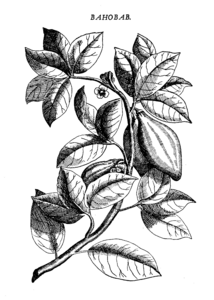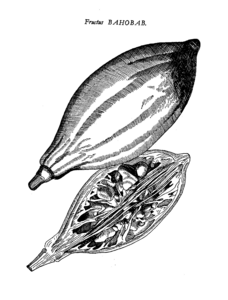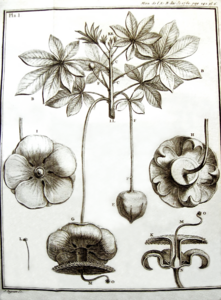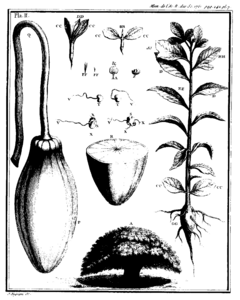Adansonia digitata
Adansonia digitata L.
| Ordre | Malvales |
|---|---|
| Famille | Malvaceae |
| Genre | Adansonia |
2n = 92, 96, 144
Origine : Afrique tropicale
sauvage et cultivé
| Français | baobab |
|---|---|
| Anglais | baobab |
- légume-feuille
- racines et fleurs comestibles
- pulpe du fruit consommée en desserts, boissons
- graines consommées crues, grillées, ou comme substitut du café
- huile des graines alimentaire et pour le savon
- coque du fruit : ustensiles
- écorce en poudre : épice
- fibres de l'écorce intérieure et de l'écorce des racines
utilisée pour des cordes, filets, paniers... - toutes les parties médicinales
- fourrage : feuilles, fleurs, fruit, graines
- bois léger utilisé pour des pirogues, flotteurs...
- arbres au tronc creux utilisés pour stocker l'eau, ou comme tombes
- pollen : colle de menuiserie
- écorce tannante
- colorant : écorce verte, racines
- substitut du tabac : pédoncule, coque du fruit
- arbre ornemental et symbolique
Sommaire
Description
Noms populaires
| français | baobab, calebassier du Sénégal, arbre de mille ans (PROTA) ; pain de singe, arbre aux calebasses / calebasse du Sénégal |
| anglais | baobab, monkey-bread tree, dead-rat tree, cream-of-tartar tree (PROTA) |
| allemand | Affenbrotbaum, Baobab |
| néerlandais | baobab, apebroodboom |
| italien | baobab |
| espagnol | baobab |
| portugais | baobab, molambeira, imbondeiro, calabaceira, cabacevre (PROTA) |
| arabe | bu ḥibāb, « père des graines » ; ba hobāb (Prosper Alpin, 1592) |
| swahili | mbuyu, mkuu hapingwa, mkuu hafungwa, muuyu (PROTA) |
Classification
Adansonia digitata L. (1759) (Sp. pl. 1753, nom. inval.)
synonyme :
- Adansonia bahobab L. (1763)
Arborem dixit summus Botanicus B. Jussiæus a discipulo egregio, qui Africa rarissimas plantas investigavit ; generis characterem non dum nobis notum ab amicissimo Auctore indefinenter expetimus. (Sp. pl. 1753). [L'éminent botaniste Bernard de Jussieu a appelé cet arbre en hommage à son distingué disciple, qui a recherché des plantes rarissimes en Afrique ; j'espère depuis longtemps [apprendre] de notre ami auteur le caractère du genre, qui ne m'est pas encore connu.] Linné ne décrit pas le genre en 1753, car il ne le connaît pas. Il ne le fait qu'en 1759.
Cultivars
Histoire
Bahobab Alpin 1735, De Plantis Aegypti, 27v ; 37
Fructus bahobab Alpin 1735, De Plantis Aegypti, 28r ; 37
Usages
BAOBAB. CORK TREE. MONKEYBREAD. SOUR GOURD. East Indies. This tree has been found in Senegal and Abyssinia, as well as on the west coast of Africa, extending to Angola and thence across the country to Lake Ngami. It is cultivated in many of the warm parts of the world. Mollien[1], in his Travels, states that to the negroes, the Baobab is perhaps the most valuable of vegetables. Its leaves are used for leaven and its bark for cordage and thread. In Senegal, the negroes use the pounded bark and the leaves as we do pepper and salt. Hooker[2] says the leaves are eaten with other food and are considered cooling and useful in restraining excessive perspiration. The fruit is much used by the natives of Sierra Leone. It contains a farinaceous pulp full of seeds, which tastes like gingerbread and has a pleasant acid flavor[3]. Brandis[4] says it is used for preparing an acid beverage. Monteiro[5] says the leaves are good to eat boiled as a vegetable and the seeds are, in Angola, pounded and made into meal for food in times of scarcity; the substance in which they are imbedded is also edible but strongly and agreeably acid.
The earliest description of the Baobab is by Cadamosto, 1454, who found at the mouth of the Senegal, trunks whose circumference he estimated at 112 feet. Perrottet says he has seen these trees 32 feet in diameter and only 70 to 85 feet high.
Cultivated in its native area and in South America, West Indies, India, Bangladesh, Sri Lanka and Java. A multipurpose tree. Young shoots, leaves, fruits, and seeds are eaten. The ripe fruits have a high amount of ascorbic acid. Therefore it is used for making drinks and to coagulate milk. The seeds are rich in vitamin B1 and phosphor. They also contain 12-15% oil, which is used as food and for the production of soap and varnish. The leaves are a good animal fodder. The bark is used for tanning. The roots contain a red dyestuff. Nets, rope, baskets, strings and paper are produced from the firm bark fibres. The light and soft wood is used in boatbuilding and to make swimmers for fishing nets. The hard fruitshell can be used as pot, hollow stems as water reservoir. Bark, leaves and fruits are also traditional medicines. Pulverized bark and leaves are utilized as spice.
Références
- Adanson, Michel, 1763. Sur un arbre d'un nouveau genre, Qui croît au Sénégal. Histoire de l'Académie Royale des Sciences, année 1761, Paris. 77-85. Gallica (87-95 du pdf)
- Adanson, Michel, 1763. Description d'un arbre d'un nouveau genre, appelé Baobab, observé au Sénégal. Histoire de l'Académie Royale des Sciences, année 1761, Paris. 218-242 + 2 planches. Gallica (426-453 du pdf)
- Bekele-Tesemma, Azene, 2007. Useful trees and shrubs for Ethiopia. Identification, propagation and management for 17 agroclimatic zones. Nairobi, ICRAF - RELMA. 550 p. (Technical Manual 6). Voir l'article
- Chauvet, Michel, 2018. Encyclopédie des plantes alimentaires. Paris, Belin. 880 p. (p. 435)
- Eyog Matig, O., Ndoye, O., Kengue, J. et Awono, A. Editeurs, 2006. Les Fruitiers Forestiers Comestibles du Cameroun. Rome, IPGRI, CIFOR, IRAD. XIV-204 p. Voir l'article
- Lost Crops of Africa. Volume II: Vegetables, 2006. Washington, National Academies Press. 354 p. en ligne
- Lost Crops of Africa. Volume III: Fruits, 2008. Washington, National Academies Press. 380 p. en ligne
- Rollet, Bernard et coll., 2010. Arbres des Petites Antilles. Tome 1 : Introduction à la dendrologie. 276 p. Tome 2 : Description des espèces. 866 p. + 46 pl. coul. + CD de photos sur l'anatomie du bois. Basse-Terre, ONF. Voir sur Pl@ntUse.
Liens
- Agroforestree
- BD des Plantes d'Afrique
- BHL
- FAO Ecocrop
- Feedipedia
- Futura Sciences : Dossier - Baobab : l'arbre pharmacien, l'arbre de vie
- GRIN
- IPNI
- Lost Crops of Africa, Fruits
- Lost Crops of Africa, Vegetables
- Mansfeld
- Multilingual Plant Name Database
- Plant List
- PROSEA sur Pl@ntUse
- PROTA sur Pl@ntUse
- TAXREF
- Tela Botanica
- Useful Tropical Plants Database
- Wikipédia
- ZimbabweFlora






























